Israel strikes in Gaza after fire balloons launched
Israel says it carried out air strikes in Gaza overnight after Palestinians launched incendiary balloons from the territory, in the first major flare-up since an 11-day conflict last month.
The Israeli military said it targeted compounds belonging to Hamas, the militant group that controls Gaza.
The incendiary balloons sparked 20 fires in southern Israel on Tuesday.
Hamas said they were a response to a march by Israeli nationalists in occupied East Jerusalem.
There were no casualties on either side and calm had been restored by Wednesday morning.
What do we know about the strikes?
In a statement, the Israel Defense Forces (IDF) said its fighter jets had hit military compounds operated by Hamas in Khan Younis and Gaza City.
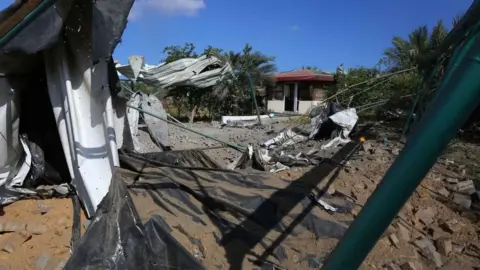 Anadolu Agency
Anadolu AgencyIt said "terrorist activity" took place in the compounds, and that the IDF was "prepared for all scenarios, including the resumption of hostilities, in the face of continued terror acts from the Gaza Strip".
The Palestinian news agency Wafa reported that aircraft bombed a site in the Maen area, south of Khan Younis, and another south of Gaza City, causing material damage.
A Hamas spokesman said on Twitter that Palestinians would continue to pursue their "brave resistance and defend their rights and sacred sites" in Jerusalem.
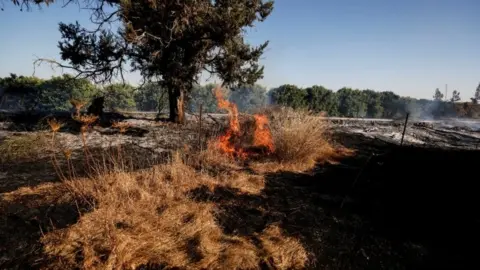 Reuters
ReutersThe IDF said the strikes were carried out in response to the "arson balloons launched from Gaza into Israel" on Tuesday.
In recent years, militants have frequently sent helium balloons and kites carrying containers of burning fuel and explosive devices over the Gaza border.
The devices have caused hundreds of fires in Israel, burning thousands of hectares of forest and farmland.
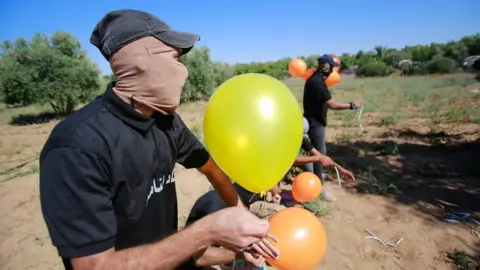 Getty Images
Getty ImagesThe air strikes were the first carried out under Israel's new government, which took office on Sunday, ending Benjamin Netanyahu's 12 years in power.
Naftali Bennett, the new prime minister, is a right-wing nationalist who heads a coalition of eight parties spanning the entire spectrum of Israeli politics.
In a separate development on Wednesday, the IDF said soldiers shot a Palestinian woman who it alleged had attempted a car ramming and stabbing attack at a checkpoint in the occupied West Bank. She is reported to have died of her wounds.

A reminder of a fragile ceasefire
by Rushdi Abu Alouf, BBC News, Gaza City
The recent air raids lasted for only 10 minutes, but they were enough to remind the city's residents, who are trying to recover from the aftermath of the recent fighting, that the ceasefire is fragile.
It is not only the sounds of explosions that remind people of the war here. You only have to drive your car or walk the streets to witness the scale of destruction that has befallen the city. Tons of rubble still block the main roads in the heart of Gaza.
A local street vendor, Abu Muhammad, sells nuts on a small cart in the Rimal neighbourhood, which was subjected to the largest strikes in the previous round of violence. He told me: "We can no longer tolerate more wars, the coronavirus pandemic stopped our work for many months, and the last war caused a great loss, I could no longer feed my six children."
A neighbour, who lives near a Hamas military site that was hit in the latest strikes, told me by phone it was scary watching new plumes of smoke rising.

What happened at the Jerusalem march?
The Jerusalem Day flag march is an annual event that marks Israel's capture of East Jerusalem - home to the Old City and its holy sites - in the 1967 Middle East War. Palestinians see it as a provocation.
At Tuesday's event, hundreds of mostly young, nationalist Israelis danced, sang and waved Israeli flags in front of the Old City's Damascus Gate, the main entrance to the Muslim Quarter.
They later entered through another gate to reach the Western Wall, one of Judaism's holiest sites.
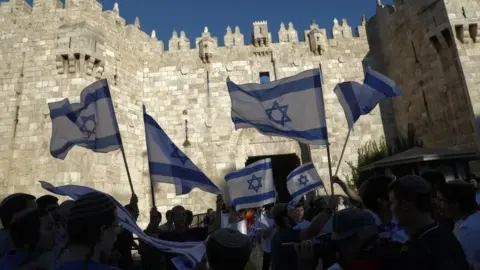 EPA
EPAIsrael's centrist Foreign Minister Yair Lapid, praised the management of the event but condemned a group of marchers who were filmed chanting racist slogans.
"The fact that there are extremists for whom the Israeli flag represents hate and racism is abominable and intolerable," said Mr Lapid. "It is incomprehensible how one can hold an Israeli flag in one's hand and shout 'Death to Arabs' at the same time."
Palestinians accused Israeli security forces of violent and discriminatory policing as the area was cleared for the march.
The Palestinian Red Crescent said at least 33 Palestinian protesters were injured in clashes with Israeli police officers, who fired stun grenades and rubber bullets.
The police force said two officers were lightly injured and that 17 people were arrested.
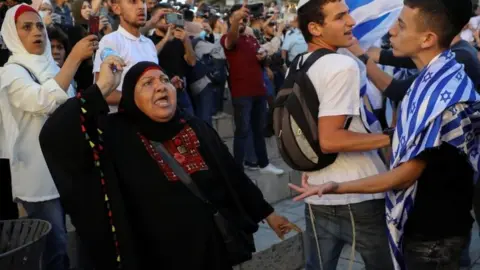 Reuters
ReutersOriginally, the flag march was supposed to take place on 10 May. But it was interrupted by Hamas militants in Gaza firing rockets towards the holy city, which led to the 11-day conflict.
As soon as a ceasefire took hold, the organisers asked for the march to be rescheduled.
It was due to take place last Thursday, but it was cancelled by the organisers after Israeli police rejected the proposed route, citing security concerns.
An amended route that avoided passing through the Damascus Gate was later approved by the new Israeli government, though the leader of the Arab Islamist Raam party in the coalition said it should have been called off.
The Palestinian Authority's prime minister warned that there could be "dangerous repercussions".
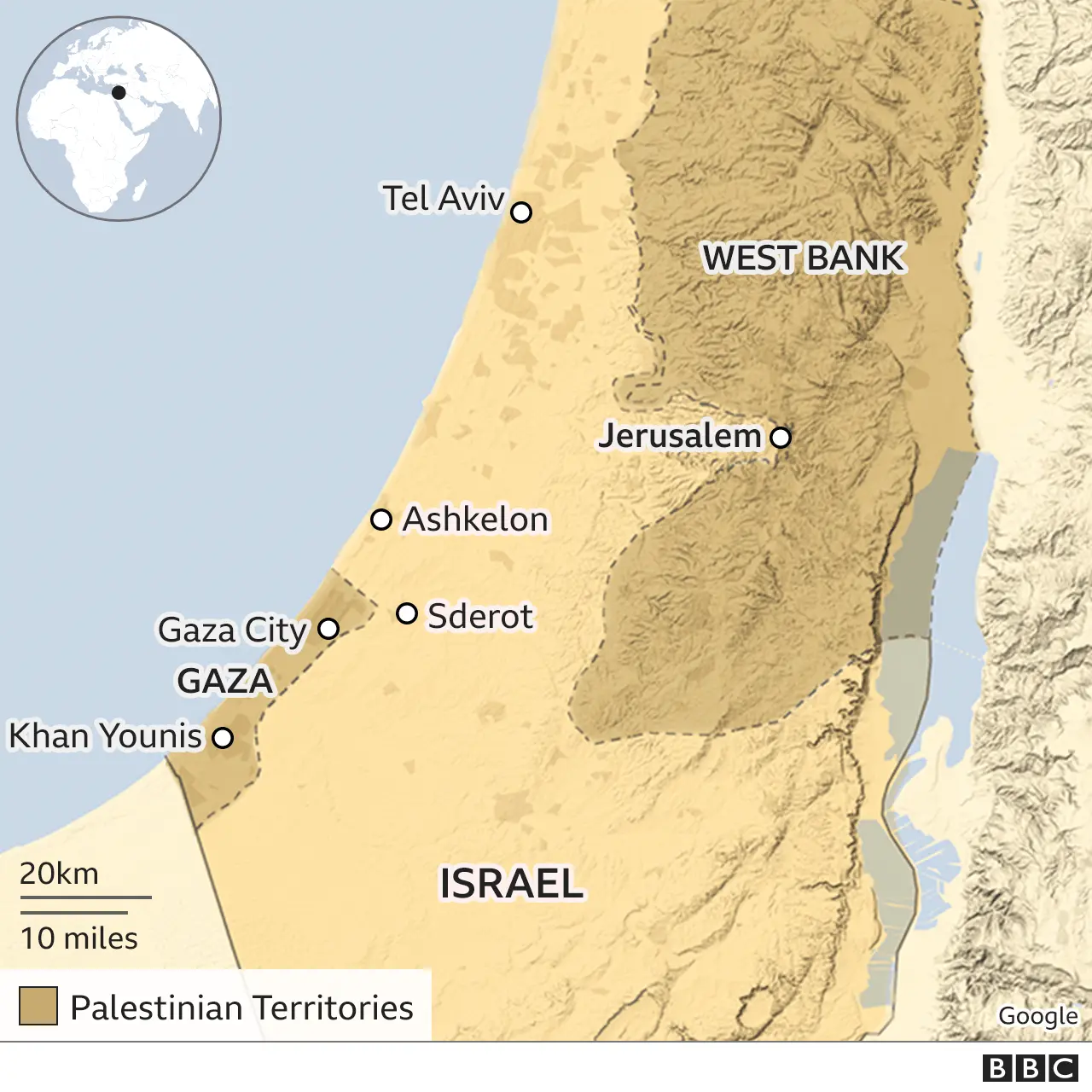

Why was there a conflict in Gaza last month?
The conflict began after weeks of spiralling Israeli-Palestinian tension in East Jerusalem which culminated in clashes at a holy site revered by both Muslims and Jews.
Hamas began firing rockets into Israel after warning it to withdraw from the site, triggering retaliatory air strikes from Israel on Gaza targets.
At least 256 people were killed in Gaza, according to the UN, and 13 people were killed in Israel before an Egyptian-brokered ceasefire took effect on 21 May.
The UN said at least 128 of those killed in Gaza were civilians. Israel's military said 200 were militants; Hamas's leader in Gaza put the number of fighters killed at 80.
More than 16,000 homes in Gaza were destroyed or damaged in the conflict, along with 58 schools and training centres, nine hospitals, 19 clinics and vital infrastructure, according to the UN.
